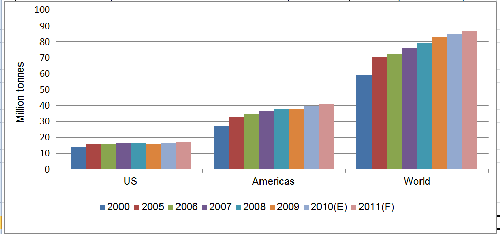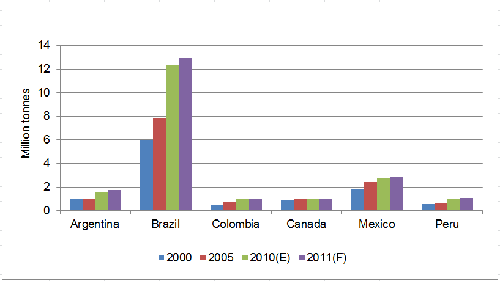



GLOBAL POULTRY TRENDS - Americas Holds Share of Global Chicken Meat Production
More rapid growth in production among the leading South American countries will enable the Americas to maintain its share of global chicken meat output at 47 per cent in 2011, writes industry watcher, Terry Evans in this, the first part of the 2011 series of Global Poultry Trends, exclusively on ThePoultrySite.It should be noted that our estimate of world production in 2011, at more than 87 million tonnes (table 1) assumes that production in India will amount to around 2.7 million tonnes. It is possible but unlikely, that the latter figure may be revised downwards, in which case the global total will need to be reduced, boosting the share accounted for by the Americas.

While production in the USA could reach a record high of more than 17 million tonnes in 2012, the annual rate of growth since 2000 has been less than two per cent, which contrasts markedly with the expansion of over seven per cent recorded by Brazil where output has risen from less than six million tonnes to close on 13 million tonnes.
Clearly, the USA has maintained its position as the leading chicken meat producer in the region (table 2) though its share of total output has fallen from 51 per cent in 2000 to an estimated 41 per cent in 2011, which contrasts with Brazil's contribution which has escalated from 22 per cent to almost 32 per cent. Lower prices resulting from the recession and higher input costs have put a brake on expansion such that, for the foreseeable future, it is likely that annual increases in the USA will fall short of two per cent, pointing to production of a little over 18 million tonnes in 2015. The cost of corn (maize) is now nearly three times as high as five years ago when the demand for corn to produce ethanol first impacted on the market. It has emerged recently is that in 2011 for the first time more corn will be used to produce fuel for cars than for animal feed.
Industry growth in Brazil since 2000 has averaged more than seven per cent a year. According to Conab, the National Supply Company of the Ministry of Agriculture, chick placings in 2011 will come close to 6.4 billion. As the average eviscerated weight has risen to around 2kg, total production should be in the region of 13 million tonnes, which will be almost double the level of 10 years ago. Despite lower profit margins as a result of higher feed costs, the industry is optimistic for increased exports and a firmer domestic demand arising from bigger disposable incomes and much higher beef prices. Continued growth in exports is vital to future expansion in production, though it is possible that currency fluctuations could play an important role here. However, even if future growth is restricted to the likely global norm of around two per cent, Brazil's output will come close to 14 million tonnes by 2015.

Mexico is the third largest producer whose output when combined with that of the USA and Brazil represents almost 80 per cent of the regional total of nearly 41 million tonnes. Since 2000, production in Mexico has expanded by almost six per cent a year, reaching nearly 2.9 million tonnes in 2008. A cut-back of some 2.5 per cent occurred in 2009, since when industry growth has risen by just over one per cent a year, so production in 2011 at an estimated 2.85 million tonnes, will just about match the 2008 level.
High and volatile feed prices are limiting growth. According to a USDA GAIN report, some 40 per cent of feed grains are sourced domestically as 60 per cent are imported. It is considered that about 73 per cent of the total demand for feed grains is covered by risk management tools aimed at mitigating the impact of high feed prices. Some producers are hedging against such price risks using a government programme Agricultura por Contrato, under which price volatility for domestic corn and sorghum is covered. The impact of price volatility will mainly hit those small and medium-sized producers who are less inclined to adopt risk management practices. Although improved consumption of chicken is anticipated as an increase in domestic demand is envisaged among the lower income groups, there are indications that some middle-class consumers are switching from chicken to beef. Nevertheless, an increase in imports, mainly from the USA, will act as a brake on production growth. With forecasts of continued relatively slow growth of possibly only one per cent or so a year, output in 2015 is projected to be around three million tonnes.
Argentina has one of the fastest expanding chicken industries in the region, the annual average increase exceeding 5.5 per cent as production has climbed from less than one million tonnes back in 2000 to possibly nearly 1.8 million tonnes in 2011. Looking further ahead, production is set to pass the two million tonnes a year mark over the next four years.
Three other countries in the Americas will produce more than a million tonnes of chicken meat in 2011 – Peru, Colombia and Canada. But, typical of the contrasts in growth between North and South America, Peru and Colombia have recorded production increases of well over six per cent a year since 2000, while in Canada industry growth has been little more than one per cent per year. As a result, output in both Peru and Columbia has overtaken Canada.
Production in Canada is tied to a strict supply-management system, with the business, in the main, in the hands of a relatively large number of independent operations. Output is controlled through a quota system. Decisions on the quantity to be produced are taken before each eight-week cycle, with the national total being allocated to each of the 10 provinces and subsequently further allocated to individual producers within each province. Future growth will be linked to population increases. Although the Farmers of Canada Strategic Plan for 2009-2013 has, as one of its objectives, the aim of increasing the average quantity of chicken eaten/person to 33kg, forecasts of annual output in 2015 vary from little change from the current level of around 1.1 million tonnes to a much more optimistic 1.34 million tonnes.
Two other countries featuring in the region's Top 10 are Venezuela and Chile. While production in the former has actually declined in recent years because of increased imports from Brazil and Argentina, output in Chile has recorded steady growth and could reach a record 625,000 tonnes in 2011. Chile's industry is highly concentrated with more than 96 per cent of production coming from just three regions – Valparaiso, Metropolitana and Libertador Bernardo O'Higgins, with nearly 60 per cent of broilers being grown in the latter. The large companies that dominate the market are fully integrated controlling growing, processing and distribution hence product traceability is high. The poultry sector is the largest meat producer in the country, accounting for nearly 46 per cent of the total.
August 2011










